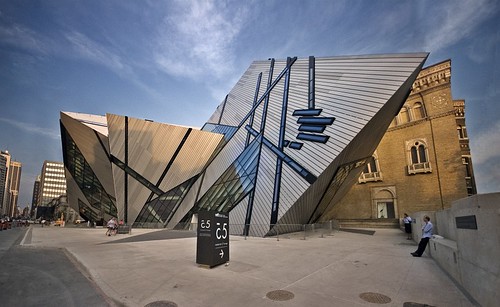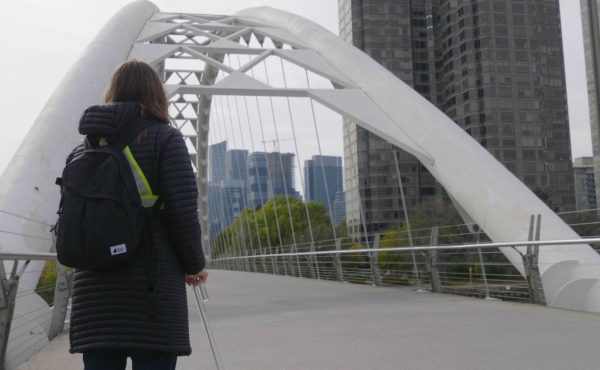
This morning, Mayor Miller and City Librarian Jane Pyper announced an expansion of the Museum & Arts Pass program. Initially kicked off 18 months ago, the Museum & Arts Pass program made a limited number of museum passes available at 24 library branches in “priority” neighbourhoods.
As of March 7, the program will expand–but more for some museums than for others.
One group of museums has agreed to expand their access program to all 99 branches of the Toronto Public Library. This means that soon library card holders will be able to pick up passes for the Art Gallery of Ontario, the Gardiner Museum of Ceramics, the Bata Shoe Museum, Black Creek Pioneer Village, the Textile Museum of Canada, the Toronto Historic Museums and the Museum of Inuit Art at all library sites.
Another, smaller, group of museums is only expanding the program to 8 more libraries, for passes available at a total of 32 branches. These museums include the Royal Ontario Museum, the Ontario Science Centre and Casa Loma.
It’s also worth noting that the admission guidelines vary for each museum. For example, where the MAP pass is good for 2 adults and 5 children at the AGO, it is only good for 2 adults and 2 children at the ROM and 2 adults and 3 children at the Gardiner.
Sun Life Financial — which co-sponsors the MAP program — also had reps at the announcement. According to Pyper, Sun Life committed $225,000 over two years to the program, and their funds are used to mainly print the passes, brochures and promotional materials. Further, according to Sun Life reps, funding right now is set to run out in 12 months, or in March 2010. Midway through this year SunLife will be re-evaluating whether their investment should be continued.
Longtime readers of Spacing Toronto will know that museum and arts access is a bit of pet cause for me. From this perspective, I can say that while this expansion of this (or any access program) is welcome, the bottom line is there are no firm numbers on arts access improvements in Toronto as of yet — no standards, no baselines, no measuring stick.
Without a benchmark of some kind — whether from here or abroad — it’s impossible to know how well we’re doing on cultural access. Without goals, any drop in the bucket can win raucous applause.
The numbers that we do have right now is that 21,000 MAP passes were picked up by Torontonians in 2008. Whether and where they were used is still being tallied up.
When asked what standards and benchmarks the city was using for on arts access, Mayor Miller said, “We’re not thinking that way. We’re trying to invest where we can in very difficult economic circumstances.” He went on, “It’s a challenge. My view is you need to ensure that young people from everywhere have a chance to express their creativity, have a chance to learn, and this program is a small part of creating that opportunity.”
The Mayor also promised more announcements soon of new arts access programs, particularly for youth.
Again on the standards issue, the AGO — which thankfully reassured me that this program expansion won’t edge out free evenings or new-citizen pass programs — is only just beginning to survey the 2,000 free-evening attendees they get every week. AGO CEO Matthew Teitelbaum stressed great interest in gaining repeat visitors, in creating an environment that will be able to welcome people back for 2 days or 20 minutes.
Though this program is a step in the right direction, it’s still far from what’s needed overall. In my most optimistic view, I’d hope it’s a signal of even more access to come — stuff like standard admission below $12, mandatory free evenings, and the like. In my most pessimistic, I’d say it’s that drop in the bucket.
Probably the best thing our museums and galleries could do right now is not just partner with the library — which Pyper recalls co-initiated the project as part of an expanded mission to provide access to information and resources — but to look to it as a model for cultural service.
On a related note, the National Gallery of Canada, which has come in for some slagging on access in the past, is having a free-admission week under a “Family Day” banner.
Photo by Miles Storey




7 comments
As always, I’ll provide the view-from-New York as an example of peer institutions in peer cities. As of Feb 2009:
A: Adult Admission
S: Student Admission
F: Free periods
*: Suggested. (Can pay $0.00 if so desired.)
Met – A: $20*, S: $10* (free for some colleges), F: none
MoMA – A: $20, S: $12 (free under 16), F: Friday eves
New Museum – A: $12, S: $8 (free under 18), F: Thursday eves
Am Mus Nat Hist – A: $15*, S: $11*, F: none
Guggenheim – A: $18, S: $15 (free under 12), F: Friday eves
Mus of City of NY – A: $9*, S: $5*, F: Sun mornings
Whitney – A: $15, S: $10 (free for public school students), F: none
Morgan – A: $12, S: $8, F: Friday eves
Nat Mus Am Indian – A: Free, S: Free, F: always
Generally speaking, I think Toronto should let the museums set their own prices BUT admission should be suggested-only for any institution that receives public funding. This allows for those without means to visit but prods those who can pay into supporting the museum.
A couple years ago, I did quite a number on the MAP program and the questionable rationale behind soliciting corporate dollars to run it: http://torontoist.com/2007/07/library_science.php
At the time, I was most disturbed by the sponsorship, but now I think I’m even more irked by the fact that some institutions consider the MAP program to absolve them of the responsibility to make their collections accessible to the public at large.
I don’t think all around free admission is a big stretch.
In the case of ROM, admissions last year brought in about $6,000,000.
While no small sum; its not that large either. It represents only about 9% of their total budget.
And the cost of issuing tickets, handling the associated transactions (cash handling, debit fees etc) as well as the required staffing and extra security to enforce the paid admission policy costs at least mid-six figures. (Its difficult to see the true costs as Visitor Services, Bldg Services and Security are all grouped together in their budget)
But the net contribution, let’s say is $5,000,000.
That can be generated in income by an endowment of approximately $100,000,000 which is about 40% of what was raised for the Crystal. A very do-able number.
Or it could be made up by an increase in total government grants of just $5,000,000 which would a hike of about 15%. Again, not an astronomical sum.
The Ago shows fairly similar, but smaller numbers by my reading of their reports. (adjusted for time closed during the renovation)
Fixing the affordability of the COC, the National Ballet and the TSO might be more challenging.
But making our large museums/galleries run largely free is not a particularly expensive or overly-ambitious undertaking.
And when one considers the potential tourism dollars for governments and the added recognition of likely substantially more visitors, it might well be a very fiscally prudent move.
The fact it would add some fairness to the City is just a bonus!
Thanks uSkyscraper for the roundup and Jonathan for the link.
I often wonder if I’m wrong to harp on these types of issues, but your comments and a recent visit to Madrid spun me ’round again.
The Prado has free admission periods 6 days a week: Tuesday to Saturday from 6 to 8pm, and Sundays from 5 to 8pm.
http://www.museodelprado.es/index.php?id=139&L=5
Further, general admission is only 6 euro — 10ish Canadian dollars.
Yes, it’s clear that our cultural institutions need improved public access strategies–whether it’s admission by donation, increased numbers of free periods, reduced admission fees overall or all of the above.
Enacting improved public access–which means budgeting and lobbying for same–should ultimately work in the interest of these institutions. The more people who visit, the more who feel part of the museum, the more who fight for or expect funding.
Devil’s advocates may say that museums used to be free/cheap and no one attended. Well, yes, marketing is important too. But there needs to be a balance. Both, not either/or!
Again, I hope this is a positive sign but I too worry about the implications of relying on private funding (12 mo-renewals? Quoi?) and on the “outsourcing” of access to the library, even if the library is happy to take it on.
Thanks James too — I think we were posting at the same time!
I appreciate your number crunching. It’s stunning to think what such an endowment could do, no?
A $100m endowment for admissions. Just for the ROM, never mind all the other cultural institutions with equal claim to free admission.
Right.
This is all very political. Many of the forces of privledge and power do not really think public institutinos should be free: it’s kind of a Steven Harper “User Pays”, skinflint philosophy. (In Calgary, for example, one BUYS a library card…) This is the hallmark of ‘user payed public infrastructure…’. Somehow, it is believed that making public institutions ‘run like busines’ is smart thinking. (A Library is NOT a business. The people who visit are NOT ‘customers’…) Imagine where we would be today if hospitals, City Halls and libraries did as Harper and (formerly Harris) has been harping, and acted like General Motors…
McQuaid.